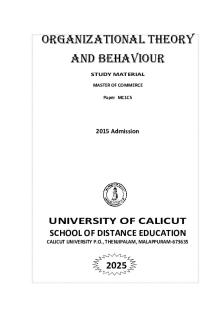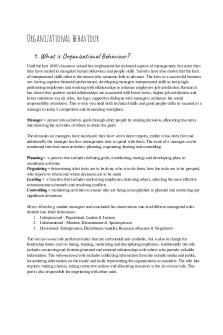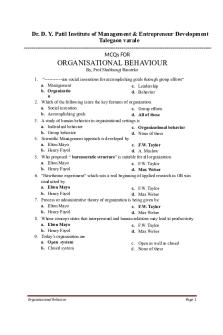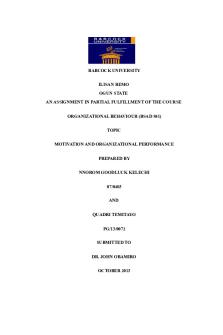Organizational Behaviour and Analysis 5 - Teams and Group Work PDF

| Title | Organizational Behaviour and Analysis 5 - Teams and Group Work |
|---|---|
| Author | John Smith |
| Course | ORGANISATIONAL BEHAVIOUR AND ANALYSIS |
| Institution | University of Surrey |
| Pages | 9 |
| File Size | 574.6 KB |
| File Type | |
| Total Downloads | 19 |
| Total Views | 130 |
Summary
Download Organizational Behaviour and Analysis 5 - Teams and Group Work PDF
Description
Organizational Behaviour Analysis 5 (Sem. 2, Yr. 1)
Organizational Behaviour and Analysis 5 – Groups and Team working Objectives 1. Define the terms group and team, and identify the purposes of groups and teams 2. Distinguish the differences between groups and teams 3. Discuss and evaluate the importance of teams and team working within organizations 4. The characteristics of effective work groups and teams 5. Explain how groups influence the behavior and performance of individuals 6. Compare individual and group productivity 7. Discuss the advantages and disadvantages of working and decision-making in groups and teams
1. Groups : “Any number of people who interact with one another, are psychologically aware of one another, and perceive themselves to be a group.” (Schein, 1988) Types of groups
• •
There are different types of groups Put into a hierarchy of types of groups
Formal
Informal
(created to accomplish a goal)
(a response to social need)
Command
Interest
Task
Friendship
Purpose of Groups • Organisational functions o Complex tasks, new/creative ideas, liaison, problem solving (bouncing ideas of each other etc), socialisation • Individual factors o Social/affiliation needs, identity/self-esteem, reducing uncertainty, power, problem solving (self-interest), humans like to interact with eachother Group Composition •
The bigger the group gets, the harder it is to ‘tick all the boxes’
•
Surface level diversity – obvious stuff you can pick up on Deep level diversity– internal factors that can take a long while to discover o Once they start working together, will bring to the table a vast level of deep diversity to help with problem solving etc.
•
•
However a breakdown as a result of diversity can lead to the formation of factions and divisions within a group
1
Organizational Behaviour Analysis 5 (Sem. 2, Yr. 1)
Group Formation/Development – Tuckman (1965) EXAM 1. Forming ▪ Beginning to know each other (e.g. Name, personality, strengths and capabilities) ▪ Introduction to the tasks, aims & objectives ▪ Initial thoughts around rules, norms, ways of working & achieving objectives ▪ Initial social and personal interaction ▪ Acquiring and setting resources 2. Storming ▪ Finding out what people are really like ▪ Putting forward their views more openly and forcefully ▪ Gaining initial ideas about the capabilities and capacities of members ▪ Mutual appraisal and assessment of expertise and process ▪ Disagreements and challenges appeared leading to initial conflicts between members ▪ Reforming arrangements for the working and operation of the team 3. Norming ▪ Establishing ways to combine group member strengths ▪ Establishing group/ team norms ▪ Controlling conflict and hostility within the team ▪ Establishing guidelines and standards/ rules and codes of conduct ▪ acceptable and unacceptable conduct, performance and activities ▪ Establishing the need for members to interact and cooperate 4. Performing ▪ Fully engage, addressing tasks/matters within the team ▪ Making good outcomes occur ▪ Getting results and assessing performance ▪ Creating structure and cohesiveness to work effectively as a team ▪ Reforming/ Rejuvenation/ Ending Later added two more: Adjourning (completion of team objectives), Mourning (not wanting to ‘let go’ of the team) Group Structure: Norms Shared expectations of how all group members ought to behave (Levine & Moreland, 1998) Can override an individual member’s self-interest (Roethlisberger & Dickson, 1939) • • • •
Performance Appearance – people in groups tend to dress the same, hairstyle etc Social arrangement – if you like working with people, will want to socialise Resource allocation – how much (money/time) will you allocate to keep the structure/group together? 2
Organizational Behaviour Analysis 5 (Sem. 2, Yr. 1)
Conformity to Group Norms – Solomon Eliot Asch 1907-1966 • Pioneer in Social Psychology • Groups tend to move towards the general consensus of the group even if it is wrong • E.g. If most people say X = A then you will tend to conform with the group opinion
Normative and Informational Social Influences
• • •
Causes/influences of conformity: Informational – we think they have info that we don't Normative – we worry about what they think and want to be liked by them/accepted socially, to belong to the group
Group Structure: Cohesiveness Forces that keep members of a group together (Festinger, 1950) Sense of ‘we-ness’ (Owen, 1985) •
•
Characterized by (Argyle, 1989)… o Membership Attraction o Clear Group Norms o Norm Compliance Determinants of Cohesiveness (staying together) o Threat / competition o Success o Homogeneity o Size o Difficulty of initiation (if you put in a lot of effort then you may be more likely to want to remain)
3
Organizational Behaviour Analysis 5 (Sem. 2, Yr. 1)
Effects of Group Cohesiveness Positive • • • • • •
Predictability & stability Morale and motivation Job satisfaction Intra-group conflict, absenteeism and quitting Norm enforcement Participation in group activities
Negative • • • • • • •
Uniformity of attitudes Pressures to conform Rejection of deviants/things that don’t fit the group norms Resistance to change Inter-group conflict ‘Groupthink’ Innovation/creativity The performance cohesiveness link is stronger than the cohesiveness performance link. (Mullen & Copper, 1994)
•
•
Compares level of cohesiveness (wanting to stay together in the same teams) with levels of performance norms (all hard working) If you have a group that is likely to stay together (high cohesiveness) and the performance norms are high (they all want to achieve the same results to the same standard) then = high productivity
4
Organizational Behaviour Analysis 5 (Sem. 2, Yr. 1)
Group Processes: Motivational Losses •
•
Ringelmann (rope-pulling experiment) o Tug of war – higher level of members, you begin to have members that doesn't put in their full amount of effort (because they perceive that they don't need to) o Known as Social Loafing ▪ Where people don’t all perform at their highest • High level of participants • Low interest in task/unclear goals • No procedure in place for checking contribution levels Brainstorming exercise 1) Evaluation apprehension – don’t want to appear to be the idiot, apprehensive about speaking up too much – best ideas don’t often tend to come out 2) Production blocking Culture-Specific! – depends on individualist or community culture 3) Social loafing o Output equity – is everyone pulling their weight? o Cover of anonymity – you don’t know who's putting in the most effort o Matching to standard – people cruising along to the average
Group Processes: Deindividuation Large groups produce a collective mindset (group mind) and social contagion. (LeBon, 1896) •
Deindividuation… o Increases obedience to group norms o Makes people feel less accountable o Fosters anonymity
• •
Are Groups Better Decision Makers? Groups produce more and higher quality solutions, but: o At the cost of more total person-hours, and o The best individual performs better than the group 5
Organizational Behaviour Analysis 5 (Sem. 2, Yr. 1)
Group Decision Making: Potential Pitfalls •
•
Group Polarisation – Groupshift o Why? o Social comparison o Persuasive argumentation Groupthink Janis (1972, 82) o When the norm for consensus overrides realistic appraisal of alternative courses of action (Robbins, 2001) o Team searches for and reaches immediate agreement o Key symptoms: ▪ Illusions of invulnerability/unanimity ▪ Pressures to conform ▪ Rationalisation ▪ Assumption of morality ▪ Stereotyping ▪ Self-censorship o E.g. NASA rocket explosion when all groups did not cover everything in detail
Features:
• • • • • •
Consequences:
Illusion of invulnerability Belief in the rectitude of the group Negative views of competitors Sanctity of group consensus Illusion of unanimity Erecting a protective shield
• • • • •
Poor decision-making Inadequate decisions Discussion limited to a few alternatives Absence of evaluation of alternatives No attempt to obtain expert opinions
Behaviour in Groups and Teams •
•
Risky Shift o The group dynamics may incline members to take more risks than its individual members would o Risk taking members have more influence o Risk-takers may be more influential in the group than the more cautious o Risk-taking may be regarded as a desirable characteristic in the group setting Cautious Shift o Cautious members have more influence o The group dynamics may incline members to take fewer risks than its individual members would o The more cautious members of the group may be more influential o Being cautious may be regarded as a desirable characteristic in the group setting 6
Organizational Behaviour Analysis 5 (Sem. 2, Yr. 1)
2. Teams “A team is a small number of people with complementary skills who are committed to a common purpose, performance goals and approach for which they hold themselves mutually accountable.” Katzenbach, J.R., (1993). The wisdom of teams : creating the high-performance organization. Boston, Mass. : Harvard Business School Press.
Key Features of this definition • • • • • •
Small number Complementary skills Committed Common purpose (win/achieve) Performance goals Mutually accountable
Work Groups vs Teams •
Teams are strongly task-oriented, formal groups.
Team: The inference we can draw from the key features of this definition is that a team is a formal, primary group of co-acting individuals.
7
Organizational Behaviour Analysis 5 (Sem. 2, Yr. 1)
Meredith Belbin’s Team Roles – these combined = perfect team ROLE PLANT
DESCRIPTION ALLOWABLE WEAKNESSES Ideas person, Creative, Ignores detail, too unorthodox, imaginative, preoccupied to solved problems communicate effectively RESOURCE INVESTIGATOR Develops contacts, Over optimistic, loses extrovert, enthusiastic, interest once initial explores opportunities enthusiasm has passed COORDINATOR Good chairperson, Can be seen as confident, mature, clarifies manipulative; delegates goals, promotes decision personal work making, delegates well SHAPER Builds on ideas, dynamic, Can provoke others, hurt thrives on pressure; has people’s feelings the drive to and courage to overcome it MONITOR EVALUATOR Keeps track of progress, Lacks drive and ability to sober, strategic, judges inspire others; overly accurately, seeks all critical opinions TEAM WORKER Cooperative, mild, Indecisive in crunch perceptive and diplomatic; situations, can be easily listens, builds, averts influenced friction, calms the nerves IMPLEMENTER Disciplined, reliable, Somewhat inflexible, slow conservative and efficient, to respond to new turns ideas into practical possibilities actions COMPLETER Proof reads, painstaking, Inclined to worry unduly; conscientious, anxious; reluctant to delegate; can searches out errors and be a nit picker omissions; delivers on time SPECIALIST Single minded, self-starting Contributes only on a dedicated; provides narrow front, swells on knowledge and skills in technicalities, overlooks rare supply the big picture It is important to create a team with complimentary roles
Team Working: Socio-technical Theory • • •
Socio-technical theory: evolved from work of the Tavistock Institute in the 1950s Autonomous work groups How much autonomy do teams actually have in reality? 8
Organizational Behaviour Analysis 5 (Sem. 2, Yr. 1)
Autonomous Teams v. Management Influence • • • • • • • • •
Who selects the team leader? Who decides/ recruits new members for the team? Who decides on the distribution of work? How flexibly can the team’s time be used? Who accepts additional work for the team to complete? How is the team represented in the wider organization? Who decides on methods of production? Who decides and sets production goals/ outputs? Who decides and sets quality goals?
Team Working: The Japanese Model • • • • • •
Organization is the team Individual responsibility to support the team’s efforts Collective spirit/ culture Use of methods such as ‘offline’ teams/ quality control circles Focus on ‘lean production’ Emphasis not placed on autonomy
Introducing Team Working • • •
Advocates regard team working as a route to improved organisational performance Teams regarded as countering negative consequences of work routinisation Potential drawbacks of team working: o May replicate external inequalities/ power dynamics o Illusion of being ‘self-managed’ o Groupthink o May galvanise organisational discontent/ politicking/ misbehaviour o Can lead to disempowerment and de-skilling
9...
Similar Free PDFs

Organizational theory and behaviour
- 186 Pages

Organizational behaviour
- 67 Pages

Organizational Behaviour
- 2 Pages

Cost behaviour and CVP analysis
- 8 Pages

Organizational Behaviour mcqs
- 27 Pages
Popular Institutions
- Tinajero National High School - Annex
- Politeknik Caltex Riau
- Yokohama City University
- SGT University
- University of Al-Qadisiyah
- Divine Word College of Vigan
- Techniek College Rotterdam
- Universidade de Santiago
- Universiti Teknologi MARA Cawangan Johor Kampus Pasir Gudang
- Poltekkes Kemenkes Yogyakarta
- Baguio City National High School
- Colegio san marcos
- preparatoria uno
- Centro de Bachillerato Tecnológico Industrial y de Servicios No. 107
- Dalian Maritime University
- Quang Trung Secondary School
- Colegio Tecnológico en Informática
- Corporación Regional de Educación Superior
- Grupo CEDVA
- Dar Al Uloom University
- Centro de Estudios Preuniversitarios de la Universidad Nacional de Ingeniería
- 上智大学
- Aakash International School, Nuna Majara
- San Felipe Neri Catholic School
- Kang Chiao International School - New Taipei City
- Misamis Occidental National High School
- Institución Educativa Escuela Normal Juan Ladrilleros
- Kolehiyo ng Pantukan
- Batanes State College
- Instituto Continental
- Sekolah Menengah Kejuruan Kesehatan Kaltara (Tarakan)
- Colegio de La Inmaculada Concepcion - Cebu










